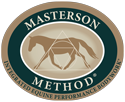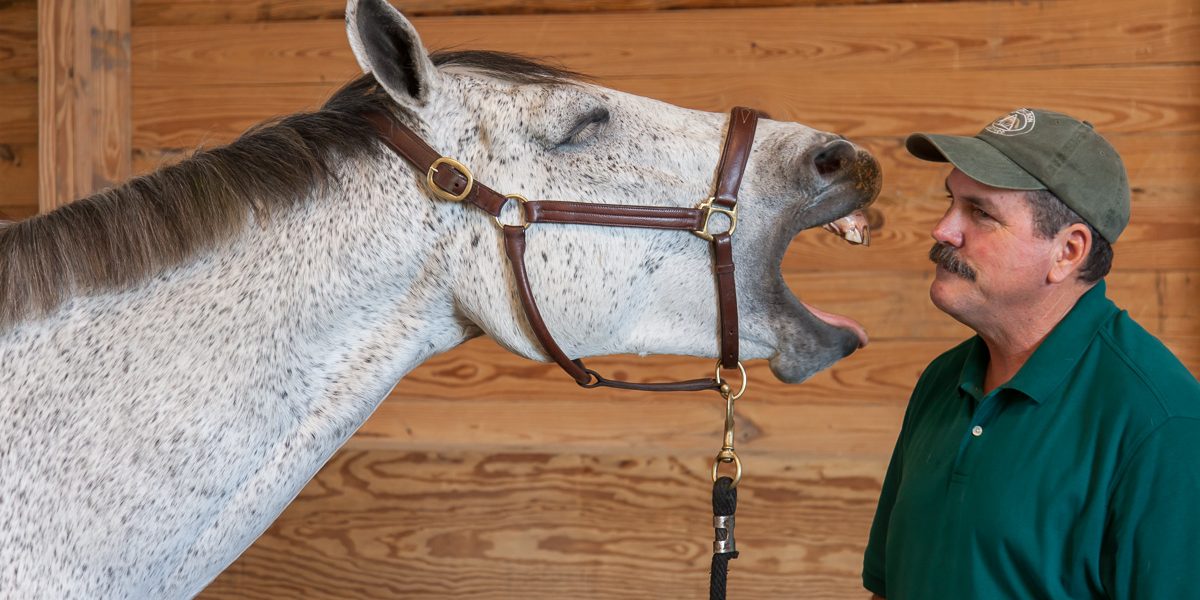by Vicky Devlin
We thought Jim’s birthday month would be the perfect time to highlight his useful mottos, or ‘Jim-isms’ that we use when teaching this work. These are just some of the tenets or principles that help us learn the subtleties of this powerful work. Here is a summary of our favorites, by Vicky Devlin, Overseas Manager and Co-director of Education and Fieldwork, in the United Kingdom.
I met Jim by accident when I offered to help a friend with a Beyond Horse Massage Weekend Course here in the UK. It was a true revelation to me when I saw the way Jim was working with the horses. He was listening to them in the same way many horse trainers do, but instead of using this information for training, he was using it to help them relax and release tension in their bodies. I was immediately hooked and over the next 18 years went from an observer to a Certified Practitioner to my current role as the Overseas Manager and Co-director of Education and Fieldwork.
Throughout this, I’ve used the Jim-isms whenever I’m teaching and have seen how students respond so positively to them. There is no doubt that although he pretends to know nothing, he is a very wise owl when it comes to the Masterson Method.
With Jim’s BIG birthday taking place this September, we wanted to highlight some of his key sayings and explain a little more about what each means in practice.
A Few Key Mottos
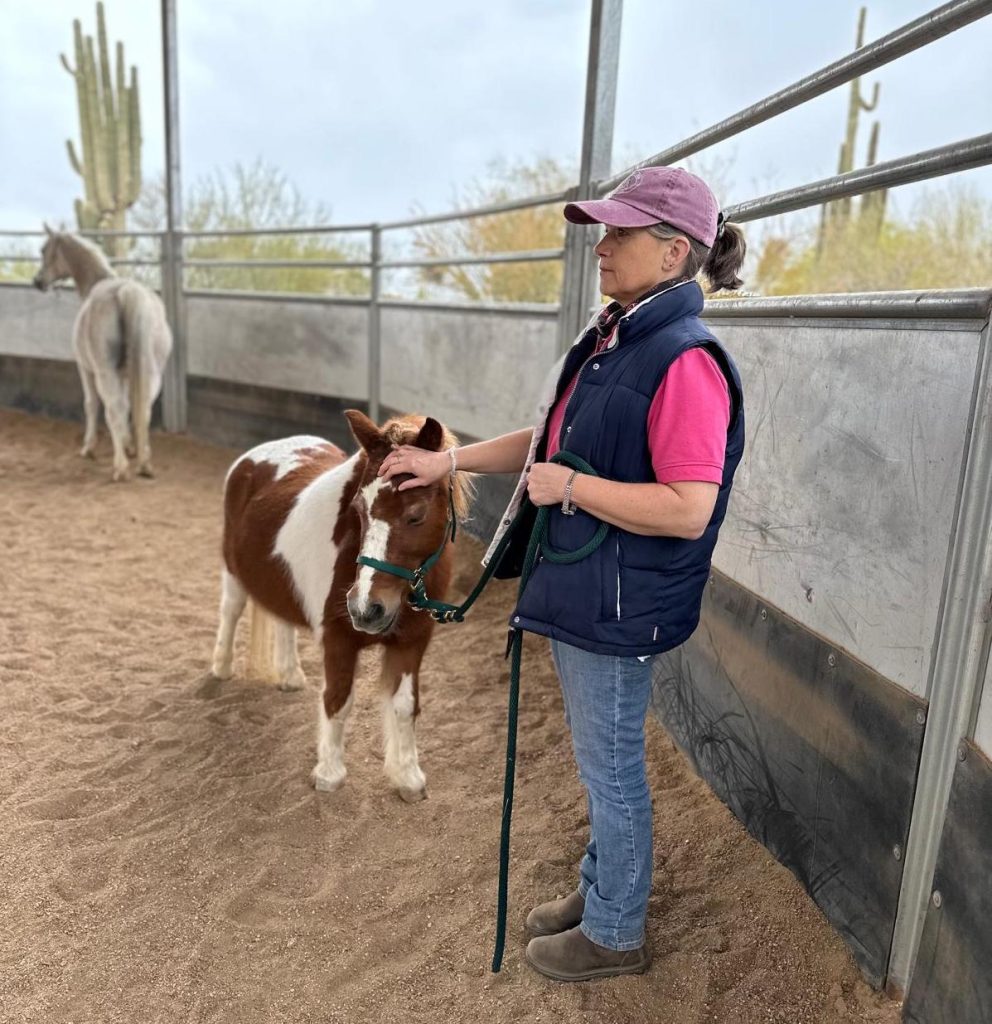
Vicky doing less with a miniature horse – and looking quite tall!
Less is More. This sounds crazy, doesn’t it? Humans put a lot of pressure on themselves and their horses to get things right. Particularly in bodywork, we often think you’ll get more relief by adding more pressure with your hands. But the opposite can actually be true. Both physically and otherwise, if you lighten the pressure on yourself and your horse, you both relax. When the horse is relaxed, movement in a relaxed state can be achieved. If a horse braces, go lighter, softer, ask for less and you will get more done.
Three Strikes You’re Out. Horses are really good at building patterns of behavior. Once they have done something 3 times, it can become a pattern. This can be good if what they are doing is what you want, but if it is something you don’t want, like pawing when you’re trying to do the front leg releases, it makes things difficult and neither of you will be in a relaxed state! If the horse says No or an undesired response happens more than 3 times in a row, it’s time to move on. This might mean changing sides or trying another technique or just stepping back to break the pattern.
Follow the Responses of the Horse. The horse is the one telling us what to do next, if you pay close attention to the horse’s responses you will become much more sensitive to what they need.
- If the horse braces, we soften.
- If the horse softens, we ask for more.
- If the horse blinks, we wait.
It’s all communication that builds trust, and once the horse realizes we are listening (and responding) to them, they relax and allow us to do so much more with them.
Throw Away the Clock. Most of us lead busy lives where we’re constantly thinking about what we have to do next. When we are working on a horse we are working on horse time not human time. Don’t worry how long things are taking; giving the horse time and taking your time will mean you get much better results.
Doubt the Doubt. We use this phrase a lot, especially when someone is learning the techniques and doubting their abilities. When things are not working it is easy to think you are doing something wrong. What Jim means is that we need to believe it is going to work, and it will, as long as we listen to what the horse has to say. If you are doubting yourself… STOP and have the confidence that you can do it.
Start Where It’s Easy. You might be thinking, “Why wouldn’t you start where it’s easy?” But it’s human nature to start on the area on the body where the horse is holding tension. However, this isn’t necessarily the easiest place to begin. If a horse finds something difficult or starts to brace, go to a different part of the body where they are more relaxed and work from there. Find where the horse says “Yes”, rather than focusing on where they’re saying “No”. You will build their trust, and gradually as the horse learns to relax, the harder things become easier. This may mean working on the other side or a different technique completely.
You Can’t Do It Wrong, You Can Only Do It Better. Often students come to a weekend course where they’re shown a technique they might have been practicing at home and they say, “I was doing that wrong all along, but they still released.” Our response is, “It wasn’t wrong, but what we are showing you is a better way to do it.” Another student new to this work might feel nervous about doing a technique wrong, and feel blocked or anxious. The beauty of the Masterson Method is there’s generally no wrong way (unless you’re getting the limbs mixed up!), so long as you’re listening and responding to the horse’s responses. By practicing and getting some hands-on instruction you can only get better. And the better we get, the more effective we are at helping our horses release tension.
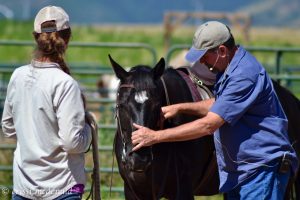
Jim softening a horse at a clinic between rides.
When the Horse Braces, Soften. When you’re working on a horse and it starts to feel something, they will often brace or tense up. It’s a natural response to feeling some tension. As you get more experienced in this work, you’ll notice how just before bracing, they will give you a cue that they are feeling this tension: we call this a response that they are feeling something. If you can spot that cue and soften at that point (before the brace), you have a good chance of avoiding the brace altogether. The clearest response is a blink, but it can be any change in behavior that correlates to what you are doing. Don’t worry if you’re not quite getting it! It can take time to develop the ‘feel’ so the more we practice, the better we get. Remember ‘you can’t do it wrong, you can only do it better’.
Peeling Away One Layer at a Time (like an onion). Think of the horse like an onion; if they have tension in an area, we want to look for a small improvement in range of motion, so we’re peeling off the first layer. The next time we work on them we ask for a little more, then a little more and eventually you will have a much larger range of motion and the horse will move more freely. Releasing tension one layer at a time gives the horse time to process between sessions. The great thing here is in between sessions the horse moves more freely and peels a few layers away themselves ready for your next session.
This also goes hand in hand with another motto, We’re Not Trying to Fix the Horse, We’re Just Looking for Improvement. Try not to focus on fixing your horse, just look for small improvements.
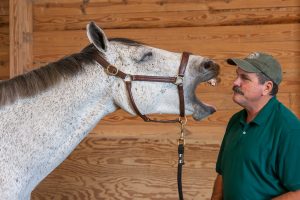
Jim stepping back; apparently Primo has lots to say!
Step Back and See What the Horse Has to Say. This is such an important Jim-ism! The time you give a horse to process what you have done is as important as the technique itself. This is where the horse’s nervous system catches up and their body can begin to let go. When you have done a technique, step back out of their space (several steps back – you can hold the very end of the lead rope if it’s safe) and see “what they have to say.” Do they lick and chew? Shake their head? Yawn? For many horses, that is when the releases happen.
You Have to Be Out of Your Mind to Do This. No, Jim’s not saying that you have to be crazy to do bodywork on horses! This goes hand in hand with another Jim-ism that ‘Thinking is Overrated.’ Try not to overthink what you are doing and just feel the horse. You will find it goes so much better. You might also discover that if you have a clear mind, random thoughts will pop into your head about what to do next. Listen to them, that is your intuition talking.
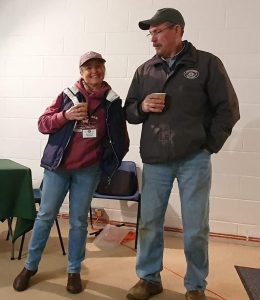
We’re not sure if this is coffee or beer, but all the same, Vicky and Jim sharing one!
Finally, this is the last motto you may hear at the end of a long day: Is there a pub near here? Anyone want to join me for a beer? This is the best one. It means Jim has put in a really good day’s work and the best thing after that is a beer with like-minded people. Not only will you enjoy his company he will enjoy yours too.
From all of us in the office, Happy Birthday Jim! You’ve come a long way and are making such an impact in the world. Thank you!!

Jim as a youngster, bathing a chimpanzee in his care.
This article was written by Vicky Devlin, MMCP, Overseas Manager and Co-director of Education and Fieldwork. Vicky lives in the UK and has spent her whole life enjoying the company of horses. She rides for pleasure enjoying long-distance treks on her ponies. For more about the author, go to Vicky Devlin, MMCP.
